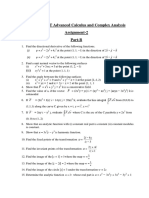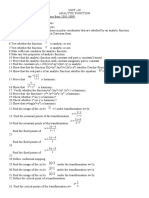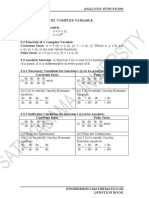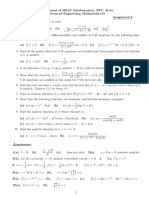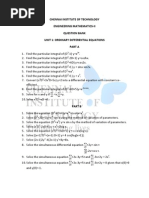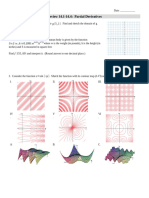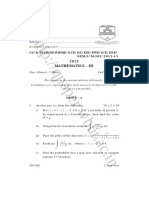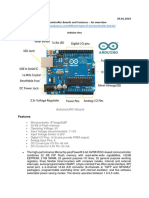Complex Lecture Notes 3
Uploaded by
Dorji TshomoComplex Lecture Notes 3
Uploaded by
Dorji TshomoTutorial Sheet:
Question No.1
1.1 If cosh(u+iv) = x+ iy, prove that x2 y2 x2 y2
+ = 1 and − =1
cosh 2 u sinh 2 u cos 2 v sin 2 v
1.2 Find the real and imaginary part of the function log(z)
x + iy y
1.3 Show that log = 2i tan −1
x − iy x
Question No.2
2.1 Show that the function f(z)= z3 is analytic in the entire Z plan.
2
2.2 Show that the function f(z) = z is differentiable only at the origin.
2.3 Show that the function f(z) = sin(z) is analytic and also show that f’(z)= cos(z)
2.4 Show that the function f(z) = z z is not analytic anywhere.
x 3 y ( y − ix )
2.5 If f ( z ) = , z 0 and f ( 0 ) = 0 , prove that f(z) is not analytic at z=0
x6 + y 2
x3 (1 + i ) − y 3 (1 − i )
2.6 Prove that the function defined by f ( z ) = , z 0 and f ( 0 ) = 0 , is not
x2 + y 2
analytic at z = 0 although C-R equations are satisfied at that point.
2.7 Verify whether w = (x2 – y2 – 2xy) + i(x2 – y2 + 2xy) is analytic function.
2.8 Show that the function f(z) = xy is not analytic at the origin although C-R equations are
satisfied
2.9 Prove that f(z) = log(z) is analytic and find its derivative.
Show that the function f ( z ) = e− z , z 0 and f ( 0 ) = 0 is not analytic at z= 0 origin although C-
−4
2.10
R equations are satisfied.
2.11 Prove that the function f(z) = cosh z is analytic and find its derivative.
2.12 Verify C-R equation of the function, f(z) = ex[cosy – i siny]
Question No.3
3.1 Show that the following functions are harmonic functions and find the analytic function having
the given functions as its real part:
(i) u= 2x(1 – y) (ii) u= y3 – 3x2y + 2y (iii) u = e-2xy sin(x2- y2)
(iv) u = 2 y 2 − 2 xy + 1
x +y
3.2 Show that the following functions are harmonic functions and find the analytic function having
the given functions as its imaginary part:
(i) v= sinh x cos y (ii) v = ex(x siny + y cosy)
3.3 If u = x2 – y2 and v = 2− y , show that both u and v are harmonic functions, but u + iv is not a
x + y2
regular(analytic) function of z
3.4 If u = log x 2 + y 2 and v = 2xy, prove that u and v are harmonic functions, but u + iv is not an
analytic function of z = x + iy
3.5 Prove that u = 2x – x3 + 3x y2 is harmonic and determine its harmonic conjugate
Page1 Jayachandran V, Assistant Professor, College of Science and Technology
Question No.4
4.1 Using Milne – Thomson Method, find the Analytic function f(z) in question No. 3.1 and 3.2
4.2 Find the analytic function f(z) whose imaginary part is:
(i) e2x(y cos 2y + x sin 2y) (ii) x4 – 6x2y2 + y4 (iii) x
x2 − y2 + 2 2
x +y
4.3 Find the analytic function f(z) = u + iv given,
e y − cos x + sin x
(i) u−v = (ii) u +v= 2
x (iii) 2u + v = ex(cosy –
cosh 2 y − cos x x +y 2
siny).
2sin 2 x
u + v = 2 y −2 y
cos x + sin x − e − y
(i) (v) u −v = , f =0
e + e − 2 cos 2 x 2 cos x − e − e
y −y
2
sin 2 x
(ii) 2u + 3v =
cosh 2 y − cos 2 x
Question No.5
5.1 Find the image of the circle z = 4 under the transformation w = z + 2 + 3i.
5.2 Find the map of the region y = 1 under the transformation w = ( 1 – i)z. Also find the map of the
region y>1.
5.3 Find the map of the circle z − 3 − 4i = 1 by the transformation w = ( 1 + i)z. Also find the map of
the exterior of the circle.
5.4 Find the map of the parabola x2 = 4y by the transformation w=2iz
5.5 Find the map of the square whose vertices are –1 –i, 1 – i, 1 + i, –1 + I, by the transformation
w =( 1 – i)z
5.6 Under the transformation w = iz + 9, find the map of the line x = 0. Also find the map of the half
plane x> 0
5.7 Find the image of the parabola y2 = 4x by the transformation w = 4z
5.8 Find the image of the parabola y2 = 4x by the transformation w = 4iz
5.9 Find the map of the region x > 0 and 0<y<2 under the transformation w = iz + 1
5.10 Find the image of the line x + y =2 under the transformation w= z 2.
5.11 Find the image of the triangular region bounded by lines x = 1, y = 1, x + y =1 under the
transformation w= z2.
5.12 Find the image of the rectangular region formed by the lines x = ½, x =1, y =½, y = 1 under the
transformation w= z2.
1
5.13 Find the image of the point 1 – 3i under the transformation w =
z
Find the image of the circle z − 3i = 3 under the transformation w = .
1
5.14
z
1
5.15 Find the image of the strip 2 < x < 3 under the transformation w = .
z
1 1
5.16 Find the image of the strip 0 < y < under the transformation w = .
2c z
Question No.6
6.1 Find the cross ratio of the following points:
(ii) 1 – i , 2 + i, 3 +2i, 3 (ii) 0, 1 – i, 2 + i, -i (iii) 2, , 3 + i, i
(iv) , 1 + i, 1 – i, – i
6.2 Find the Mobius transformation which maps the points z = 0, 1, into the points w = –5, –1, 3
respectively. Also find the invariant points of the transformation
Page2 Jayachandran V, Assistant Professor, College of Science and Technology
6.3 Find the bilinear transformation which maps the points z = 0, i, 2i into the points w = 5i, , i
3
respectively.
6.4 Find the bilinear transformation that maps the points z = 0, -1, into the points w = -1, -2-i, i
respectively.
6.5 Find the bilinear transformation which maps the points z = 1, i, -1 into the points w = i, 0, -i.
Hence find the image of the region z 1 . Also find the fixed points of the transformation.
6.6 Find the image of the line y = 0 under the transformation w = i − z
i+z
Question No.7
Evaluate the following integrals:
( e + z ) dz , where C is the circle x + y =4
7.1 z 2 2 2
z2
7.2 z − 4 dz , where C is the circle z −1 + i = 2
C
2z +1
7.3
C
z − 4z + 3
2
dz , where C is the circle z + 5 = 2
dz
7.4 Evaluate 2 , where C is the circle z = 1
C
z + 2z + 2
2
sin dz
7.5 Show that 17 + 8cos d = 0 , using the integral C z + 4 where C is the circle
0
z =1
Question No.8
Evaluate the following integrals:
cos z
8.1 z
C
2
− 1
dz , where C is the circle (i) z − 1 = 1 and (ii) z + 1 = 1 (ii) z − 5 + 3i = 1
cos z
8.2 C z 2 − 3z + 2 dz , where C is the circle z −1 = 2
1 − 2z
C z ( z − 1)( z − 2) dz , where C is the circle z = 2
3
8.3
cos z
8.4 C z 2 − 1 dz , where C is a rectangle with vertices at 2 i, − 2 i
sin z 2 + cos z 2
8.5 Evaluate dz , where C is the circle z = 2
C ( z − 1 )( z − 2 )
z dz
8.6 , where c is the circle z = 2
C ( 9 − z ) ( z + 1)
2
Page3 Jayachandran V, Assistant Professor, College of Science and Technology
Question No.9
Evaluate the following integrals:
cos z
9.1
C
( z − 1)( z − 2) dz , where C is the circle z −1 = 2
sin 2 z
9.2 dz , where C is the circle z = 1
3
z−
C
6
z2 +1
9.3 Evaluate dz , where C is the circle z − 1 = 1 .
C
z 2 −1
z 1
9.4
C
( z − 1)( z − 2) 2
dz , where C is the circle z − 2 =
2
z2
9.5 Evaluate
C ( z + 1)
2 2
dz ,where C is the circle z − i = 1
z2 +1
9.6 Evaluate dz , where C is the circle z − 1 = 1
C ( z − 1)
2 2
tan z
9.7 dz , where C is the circle z = 1
2
z−
C
4
z2 +1
9.8 z 2 − 1dz , where C is the circle z − 1 = 1
C
2
If C is any closed curve enclosing the origin, show that a = 1 a en +1 dz
n n az
9.9
n! 2 i C n ! z
Question No.10
10.1 Expand tan(z) in a Taylor’s series about z =
4
1
10.2 Obtain a Taylor series expansion of the function f ( z ) = about the point z = 2.
( z + 1)( z + 3)
Also find the region of convergence and radius of convergence of the series
1
Show that when z + 1 1, 2 = 1 + ( n + 1)( z + 1)
n
10.3
z n =1
1− z
10.4 Obtain the Taylor series expansion of f ( z ) = in powers of (z-1). State the region of
z2
validity.
1
10.5 Find the Taylor series expansion of the function f ( z ) = about z= -i. Also find the
(1 + z )
2
region and radius of convergence of the series.
Page4 Jayachandran V, Assistant Professor, College of Science and Technology
Question No.11
4z2 + 2z − 4
Expand f ( z ) = in Laurent’s Series valid in the region 2 z − 2 4
z ( z 2 − 4)
11.1
z2 −1
11.2 Expand f ( z ) = in a Laurent’s series valid in the regions:
( z + 2 )( z + 3)
(i ) z 2 (ii ) 2 z 3 (iii ) z 3
1
11.3 Expand f ( z ) = in a Laurent’s series valid in the regions:
( z − 1)( z − 2 )
(i ) z −1 1 (ii ) 0 z − 2 1
ez
z ( z 2 + 1)
11.4 Obtain the first four terms of the Laurent’s Series expansion of in ascending powers
of z valid in 0 z 1
z2
11.5 Write all possible Laurent series for the function f ( z ) = about the singularity
( z − 1) ( z + 3)
2
z=1. State the region of convergence in each case.
ez
11.6 Find the Laurent’s series expansion of f ( z ) = about z = 1
( z − 1)
2
z +3
11.7 Expand f(z) = in Laurent series valid for the region z 1
z ( z + 1)( z − 2 )
Question No.12
12.1 Using Cauchy’s residues theorem, evaluate all the integrals in Question No. 9.
dz
12.2 If C is any closed curve enclosing the origin, show that 2 z = −2 i
C
ze
sin 2 z
12.3 Evaluate dz , where C is the circle z = 1
2
z−
C
4
12.4 If C is the circle z = 2 , show that tan z dz = −4 i
C
z
1
12.5 Evaluate 2
e z
dz , where C is the unit circle
C
dz 3
12.6 Using Cauchy’s Residue theorem, ( z + 1) ( z
C
2 2
+ 4)
, where C is the circle z = .
2
Question No.13
2
cos 3
13.1 Using Contour integration, show that 5 − 4cos d = 12
0
2
d 2
13.2 Show that 1 − 2 p cos + p
0
2
=
1 − p2
if p 1
2
cos 3
13.3 5 − 4 cos d = 12
0
Page5 Jayachandran V, Assistant Professor, College of Science and Technology
2
sin 2
13.4
0
a + b cos
d , a b0
d
13.5 a
0
2
+ sin
2
=
a 1 + a2
Question No.14
dx
14.1 Using Contour integration, show that x
0
4
+a 4
=
2 2 a3
dx
14.2 Evaluate
(x + a2 )
2 2
0
x 2 dx
14.3 Evaluate
(1 + x )
−
2 3
log (1 + x )
2
14.4 Show that dx = log 2
1+ x
0
2
cos x dx
14.5 Evaluate (x
0
2
+ 4 )( x 2 + 9 )
cos x dx
14.6 Evaluate
0 (1 + x ) 2 2
Page6 Jayachandran V, Assistant Professor, College of Science and Technology
You might also like
- 18 MAB 102 T Advanced Calculus and Complex Analysis-Assignment-2 PDFNo ratings yet18 MAB 102 T Advanced Calculus and Complex Analysis-Assignment-2 PDF3 pages
- MA2002D - Tutorial1 Winter 2022-23-05.01.2023No ratings yetMA2002D - Tutorial1 Winter 2022-23-05.01.20233 pages
- Ma201 Mathematics Iii: Tutorial Problems Complex AnalysisNo ratings yetMa201 Mathematics Iii: Tutorial Problems Complex Analysis7 pages
- Topic Wise Practice Questions - Module-1No ratings yetTopic Wise Practice Questions - Module-17 pages
- Bachelor'S Degree Programme (BDP) Term-End Examination June, 2017No ratings yetBachelor'S Degree Programme (BDP) Term-End Examination June, 20174 pages
- MTH 324 (Complex Analysis) Lecture # 3 (Functions of A Complex Variable) FunctionNo ratings yetMTH 324 (Complex Analysis) Lecture # 3 (Functions of A Complex Variable) Function3 pages
- Do Any Three Questions From Section A and Two From Section BNo ratings yetDo Any Three Questions From Section A and Two From Section B2 pages
- BTMA 301: Quiz, Assignment & QB Unit - INo ratings yetBTMA 301: Quiz, Assignment & QB Unit - I20 pages
- T_Sheet_7_2023_2024_Differential_CalculusNo ratings yetT_Sheet_7_2023_2024_Differential_Calculus3 pages
- III Semester Ec, Ee, Ice, BM - I AssignmentNo ratings yetIII Semester Ec, Ee, Ice, BM - I Assignment2 pages
- Assignment-Ii: y X y Dy DX Dy DX X y andNo ratings yetAssignment-Ii: y X y Dy DX Dy DX X y and1 page
- S.Y.B.sc. Mathematics (MTH - 221) Question BankNo ratings yetS.Y.B.sc. Mathematics (MTH - 221) Question Bank14 pages
- HT TP: //qpa Pe R.W But .Ac .In: Mathematics - IiiNo ratings yetHT TP: //qpa Pe R.W But .Ac .In: Mathematics - Iii4 pages
- APPM 4360/5360 Homework #2 Solutions Spring 2016: X y X yNo ratings yetAPPM 4360/5360 Homework #2 Solutions Spring 2016: X y X y6 pages
- Factoring and Algebra - A Selection of Classic Mathematical Articles Containing Examples and Exercises on the Subject of Algebra (Mathematics Series)From EverandFactoring and Algebra - A Selection of Classic Mathematical Articles Containing Examples and Exercises on the Subject of Algebra (Mathematics Series)No ratings yet
- Plate Load Test Din 18134 Ev1ev2 Lab FormNo ratings yetPlate Load Test Din 18134 Ev1ev2 Lab Form1 page
- Actual4Test: Actual4test - Actual Test Exam Dumps-Pass For IT Exams100% (1)Actual4Test: Actual4test - Actual Test Exam Dumps-Pass For IT Exams4 pages
- Test Scenarios of Youtube: Practical No. 1No ratings yetTest Scenarios of Youtube: Practical No. 184 pages
- L9 Microcontroller Boards&Features OverviewNo ratings yetL9 Microcontroller Boards&Features Overview8 pages
- SW Full M16X2PX70 A193 B7 ZN Al SM0000000002 - BlankingNo ratings yetSW Full M16X2PX70 A193 B7 ZN Al SM0000000002 - Blanking1 page
- Lecture 2-2: Robotics Robotics and and Automation AutomationNo ratings yetLecture 2-2: Robotics Robotics and and Automation Automation8 pages
- Microprocessor_Lab_Manual Final for PrintNo ratings yetMicroprocessor_Lab_Manual Final for Print19 pages
- What Is The Momentum of A 23 KG Cannon Shell Going 530 MNo ratings yetWhat Is The Momentum of A 23 KG Cannon Shell Going 530 M13 pages
- Seismic Performance of Damped-Outrigger System Incorporating Buckling-Restrained BracesNo ratings yetSeismic Performance of Damped-Outrigger System Incorporating Buckling-Restrained Braces12 pages
- 18 MAB 102 T Advanced Calculus and Complex Analysis-Assignment-2 PDF18 MAB 102 T Advanced Calculus and Complex Analysis-Assignment-2 PDF
- Ma201 Mathematics Iii: Tutorial Problems Complex AnalysisMa201 Mathematics Iii: Tutorial Problems Complex Analysis
- Bachelor'S Degree Programme (BDP) Term-End Examination June, 2017Bachelor'S Degree Programme (BDP) Term-End Examination June, 2017
- MTH 324 (Complex Analysis) Lecture # 3 (Functions of A Complex Variable) FunctionMTH 324 (Complex Analysis) Lecture # 3 (Functions of A Complex Variable) Function
- Do Any Three Questions From Section A and Two From Section BDo Any Three Questions From Section A and Two From Section B
- HT TP: //qpa Pe R.W But .Ac .In: Mathematics - IiiHT TP: //qpa Pe R.W But .Ac .In: Mathematics - Iii
- APPM 4360/5360 Homework #2 Solutions Spring 2016: X y X yAPPM 4360/5360 Homework #2 Solutions Spring 2016: X y X y
- Factoring and Algebra - A Selection of Classic Mathematical Articles Containing Examples and Exercises on the Subject of Algebra (Mathematics Series)From EverandFactoring and Algebra - A Selection of Classic Mathematical Articles Containing Examples and Exercises on the Subject of Algebra (Mathematics Series)
- Differentiation (Calculus) Mathematics Question BankFrom EverandDifferentiation (Calculus) Mathematics Question Bank
- Actual4Test: Actual4test - Actual Test Exam Dumps-Pass For IT ExamsActual4Test: Actual4test - Actual Test Exam Dumps-Pass For IT Exams
- SW Full M16X2PX70 A193 B7 ZN Al SM0000000002 - BlankingSW Full M16X2PX70 A193 B7 ZN Al SM0000000002 - Blanking
- Lecture 2-2: Robotics Robotics and and Automation AutomationLecture 2-2: Robotics Robotics and and Automation Automation
- What Is The Momentum of A 23 KG Cannon Shell Going 530 MWhat Is The Momentum of A 23 KG Cannon Shell Going 530 M
- Seismic Performance of Damped-Outrigger System Incorporating Buckling-Restrained BracesSeismic Performance of Damped-Outrigger System Incorporating Buckling-Restrained Braces

